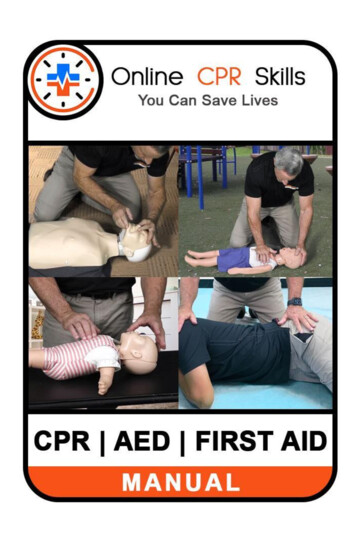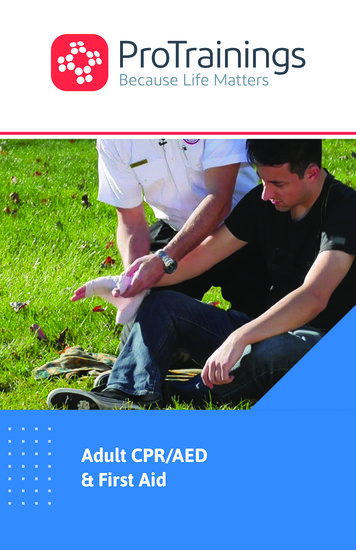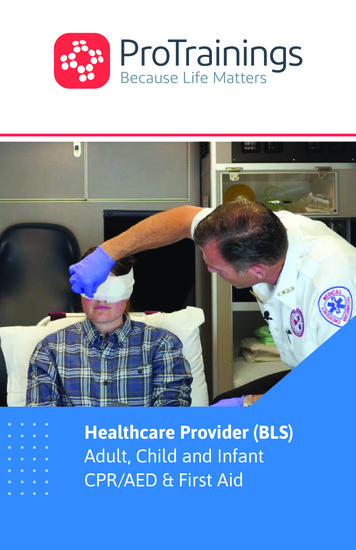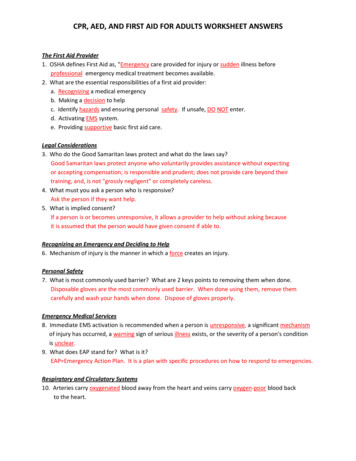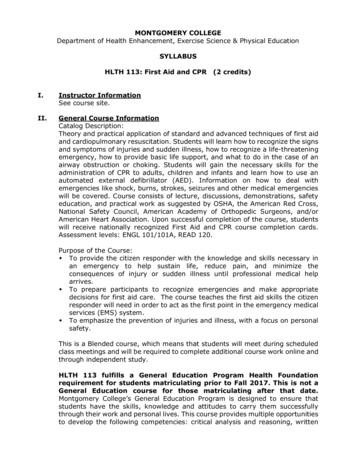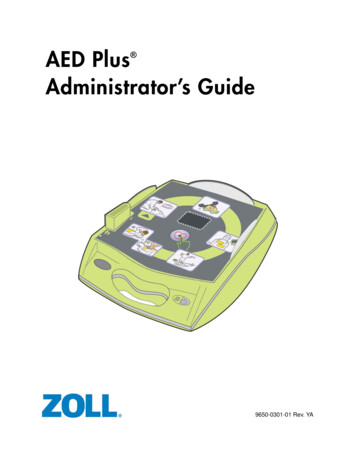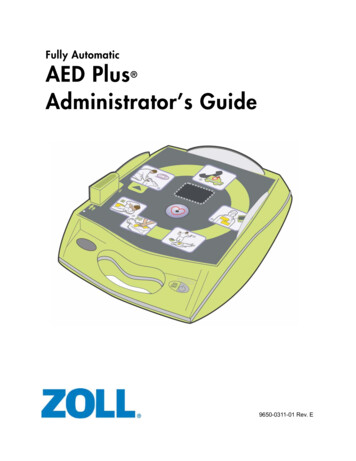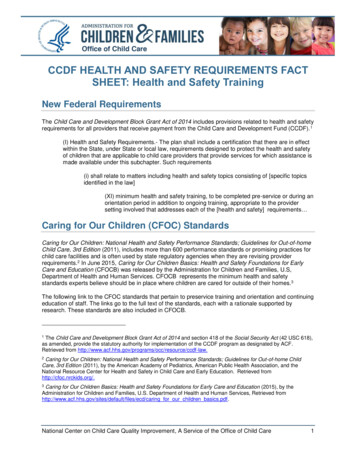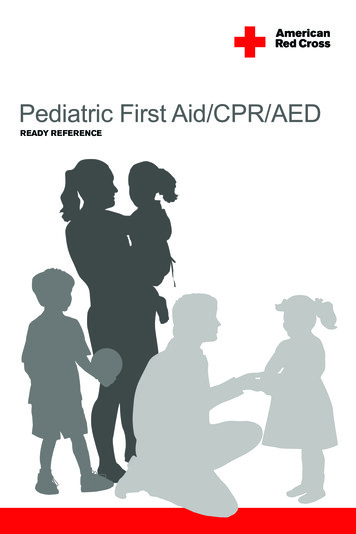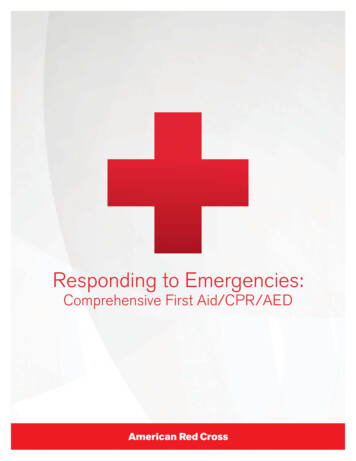
Transcription
Responding to Emergencies:Comprehensive First Aid/CPR/AED
Table of ContentsAbout This Course . . . . . . . . . . . . . . . . . . . . . . . xPART ONEIntroduction / 1PART FIVEMedical Emergencies / 254CHAPTER 1If Not You Who? . . . . . . . . . 2CHAPTER 15 Sudden Illnesses. . . . . . . . . 255CHAPTER 2Responding toan Emergency . . . . . . . . . . . . 15CHAPTER 16 Poisoning . . . . . . . . . . . . . . . 276CHAPTER 3Before Giving Care . . . . . . . . 25CHAPTER 17 Bites and Stings . . . . . . . . . 297CHAPTER 18 Substance Abuseand Misuse . . . . . . . . . . . . . . 317PART TWOAssessment / 40CHAPTER 4The Human Body . . . . . . . . . 41CHAPTER 5Checking the Person . . . . . . 62CHAPTER 19 Heat-Related Illnessesand Cold-RelatedEmergencies . . . . . . . . . . . . 335PART SIXSpecial Situations / 352PART THREELife-Threatening Emergencies / 78CHAPTER 20 Water-RelatedEmergencies . . . . . . . . . . . . 353CHAPTER 6Cardiac Emergencies . . . . . . 79CHAPTER 21 Pediatric, Older Adultand Special Situations . . . . 364CHAPTER 7Breathing Emergencies . . . 111CHAPTER 8Bleeding . . . . . . . . . . . . . . . . 139CHAPTER 9Shock. . . . . . . . . . . . . . . . . . . 152PART FOURInjuries / 158CHAPTER 22 Emergency Childbirth. . . . . 384CHAPTER 23 Disaster, Remoteand WildernessEmergencies . . . . . . . . . . . . 398CHAPTER 10 Soft Tissue Injuries. . . . . . . 159Answers to Readyto Respond? Questionsand Answers to StudyQuestions . . . . . . . . . . . . . . 421CHAPTER 11 Musculoskeletal Injuries . . . 185Glossary . . . . . . . . . . . . . . . . . . . . . . . . . . . 441CHAPTER 12 Injuries to theExtremities . . . . . . . . . . . . . . 200Sources . . . . . . . . . . . . . . . . . . . . . . . . . . . . 452CHAPTER 13 Injuries to the Head,Neck or Spine . . . . . . . . . . . 226APPENDIXPhotography Credits . . . . . . . . . . . . . . . . 455Index . . . . . . . . . . . . . . . . . . . . . . . . . . . . . . 456CHAPTER 14 Injuries to the Chest,Abdomen and Pelvis. . . . . . 242Responding to Emergencies iv Table of Contents
Detailed Table of ContentsAbout This Course . . . . . . . . . . . . . . . . . . . . . . . xPART ONEIntroduction / 1PART TWOAssessment / 40CHAPTER 1If Not You Who?, 2CHAPTER 4The Human Body, 41Objectives . . . . . . . . . . . . . . . . . . . . . . . . . . . . . . . 3Key Terms . . . . . . . . . . . . . . . . . . . . . . . . . . . . . . . 3Introduction . . . . . . . . . . . . . . . . . . . . . . . . . . . . . . 4Types of Emergencies . . . . . . . . . . . . . . . . . . . . . 4Your Role in an Emergency . . . . . . . . . . . . . . . . . 4Preparing for an Emergency . . . . . . . . . . . . . . . . 6Incident Stress . . . . . . . . . . . . . . . . . . . . . . . . . . 12Summary . . . . . . . . . . . . . . . . . . . . . . . . . . . . . . . 13Ready to Respond? . . . . . . . . . . . . . . . . . . . . . . 13Study Questions . . . . . . . . . . . . . . . . . . . . . . . . . 14Objectives . . . . . . . . . . . . . . . . . . . . . . . . . . . . . . 42Key Terms . . . . . . . . . . . . . . . . . . . . . . . . . . . . . . 42Introduction . . . . . . . . . . . . . . . . . . . . . . . . . . . . . 43Anatomical Terms . . . . . . . . . . . . . . . . . . . . . . . . 43Body Systems . . . . . . . . . . . . . . . . . . . . . . . . . . . 46Interrelationships of Body Systems. . . . . . . . . . 59Summary . . . . . . . . . . . . . . . . . . . . . . . . . . . . . . . 59Ready to Respond? . . . . . . . . . . . . . . . . . . . . . . 59Study Questions . . . . . . . . . . . . . . . . . . . . . . . . . 60CHAPTER 5Checking the Person, 62CHAPTER 2Responding to an Emergency, 15Objectives . . . . . . . . . . . . . . . . . . . . . . . . . . . . . . 63Key Terms . . . . . . . . . . . . . . . . . . . . . . . . . . . . . . 63Introduction . . . . . . . . . . . . . . . . . . . . . . . . . . . . . 63Checking for Life-ThreateningConditions. . . . . . . . . . . . . . . . . . . . . . . . . . 63Checking a Responsive Person . . . . . . . . . . . . 66Interviewing the Person . . . . . . . . . . . . . . . . . . . 69Checking the Person from Head to Toe . . . . . . 69Checking for Shock . . . . . . . . . . . . . . . . . . . . . . 71Summary . . . . . . . . . . . . . . . . . . . . . . . . . . . . . . . 71Ready to Respond? . . . . . . . . . . . . . . . . . . . . . . 71Study Questions . . . . . . . . . . . . . . . . . . . . . . . . . 72Objectives . . . . . . . . . . . . . . . . . . . . . . . . . . . . . . 16Key Term . . . . . . . . . . . . . . . . . . . . . . . . . . . . . . . 16Introduction . . . . . . . . . . . . . . . . . . . . . . . . . . . . . 16Taking Action: The Emergency Action Steps . . 16Summary . . . . . . . . . . . . . . . . . . . . . . . . . . . . . . . 23Ready to Respond? . . . . . . . . . . . . . . . . . . . . . . 23Study Questions . . . . . . . . . . . . . . . . . . . . . . . . . 24CHAPTER 3Before Giving Care, 25Objectives . . . . . . . . . . . . . . . . . . . . . . . . . . . . . . 26Key Terms . . . . . . . . . . . . . . . . . . . . . . . . . . . . . . 26Introduction . . . . . . . . . . . . . . . . . . . . . . . . . . . . . 27Preventing Disease Transmission . . . . . . . . . . . 27Legal Considerations . . . . . . . . . . . . . . . . . . . . . 32Reaching and Moving a Person. . . . . . . . . . . . . 34Summary . . . . . . . . . . . . . . . . . . . . . . . . . . . . . . . 37Ready to Respond? . . . . . . . . . . . . . . . . . . . . . . 37Study Questions . . . . . . . . . . . . . . . . . . . . . . . . . 37Skill Sheets5-1: Checking a Responsive Person . . . . . . . . 745-2: Checking a Person Who Appearsto Be Unresponsive . . . . . . . . . . . . . . . . . . 76Skill Sheet3-1: Removing DisposableLatex-Free Gloves . . . . . . . . . . . . . . . . . . . 39Responding to Emergencies v Detailed Table of Contents
PART THREELife-Threatening Emergencies / 78CHAPTER 6Cardiac Emergencies, 79CHAPTER 8Bleeding, 139Objectives . . . . . . . . . . . . . . . . . . . . . . . . . . . . . . 80Key Terms . . . . . . . . . . . . . . . . . . . . . . . . . . . . . . 80Introduction . . . . . . . . . . . . . . . . . . . . . . . . . . . . . 81Cardiovascular Disease . . . . . . . . . . . . . . . . . . . 81Heart Attack . . . . . . . . . . . . . . . . . . . . . . . . . . . . 82Angina Pectoris. . . . . . . . . . . . . . . . . . . . . . . . . . 84Cardiac Arrest. . . . . . . . . . . . . . . . . . . . . . . . . . . 85CPR . . . . . . . . . . . . . . . . . . . . . . . . . . . . . . . . . . . 88AED . . . . . . . . . . . . . . . . . . . . . . . . . . . . . . . . . . . 88Summary . . . . . . . . . . . . . . . . . . . . . . . . . . . . . . . 99Ready to Respond? . . . . . . . . . . . . . . . . . . . . . . 99Study Questions . . . . . . . . . . . . . . . . . . . . . . . . 100Objectives . . . . . . . . . . . . . . . . . . . . . . . . . . . . . 140Key Terms . . . . . . . . . . . . . . . . . . . . . . . . . . . . . 140Introduction . . . . . . . . . . . . . . . . . . . . . . . . . . . . 141The Blood and Blood Vessels . . . . . . . . . . . . . 141When Severe Bleeding Occurs . . . . . . . . . . . 142External Bleeding . . . . . . . . . . . . . . . . . . . . . . . 142Internal Bleeding . . . . . . . . . . . . . . . . . . . . . . . . 147Summary . . . . . . . . . . . . . . . . . . . . . . . . . . . . . . 148Ready to Respond? . . . . . . . . . . . . . . . . . . . . . 148Study Questions . . . . . . . . . . . . . . . . . . . . . . . . 149Skill Sheets6-1: Giving CPR to an Adult . . . . . . . . . . . . . . 1036-2: Giving CPR to a Child . . . . . . . . . . . . . . 1056-3: Giving CPR to an Infant. . . . . . . . . . . . . . 1076-4: Using an AED . . . . . . . . . . . . . . . . . . . . . . 109CHAPTER 7Breathing Emergencies, 111Objectives . . . . . . . . . . . . . . . . . . . . . . . . . . . . . 112Key Terms . . . . . . . . . . . . . . . . . . . . . . . . . . . . . 112Introduction . . . . . . . . . . . . . . . . . . . . . . . . . . . . 112The Breathing Process. . . . . . . . . . . . . . . . . . . 113Respiratory Distress and Respiratory Arrest . . 114Asthma. . . . . . . . . . . . . . . . . . . . . . . . . . . . . . . . 118Choking . . . . . . . . . . . . . . . . . . . . . . . . . . . . . . . 121Summary . . . . . . . . . . . . . . . . . . . . . . . . . . . . . . 128Ready to Respond? . . . . . . . . . . . . . . . . . . . . . 128Study Questions . . . . . . . . . . . . . . . . . . . . . . . . 129Skill Sheets8-1: Using Direct Pressure to ControlExternal Bleeding . . . . . . . . . . . . . . . . . . . 1508-2: Using a Commercial Tourniquet . . . . . . . 151CHAPTER 9Shock, 152Objectives . . . . . . . . . . . . . . . . . . . . . . . . . . . . . 153Key Terms . . . . . . . . . . . . . . . . . . . . . . . . . . . . . 153Introduction . . . . . . . . . . . . . . . . . . . . . . . . . . . . 153Shock. . . . . . . . . . . . . . . . . . . . . . . . . . . . . . . . . 153Summary . . . . . . . . . . . . . . . . . . . . . . . . . . . . . . 156Ready to Respond? . . . . . . . . . . . . . . . . . . . . . 156Study Questions . . . . . . . . . . . . . . . . . . . . . . . . 157Skill Sheets7-1: Assisting with an Asthma Inhaler . . . . . . 1317-2: Caring for an Adult Who Is Choking . . . 1337-3: Caring for a Child Who Is Choking . . . . 1357-4: Caring for an Infant Who Is Choking . . . 137Responding to Emergencies vi Detailed Table of Contents
PART FOURInjuries / 158CHAPTER 10Soft Tissue Injuries, 159CHAPTER 13Injuries to the Head,Neck or Spine, 226Objectives . . . . . . . . . . . . . . . . . . . . . . . . . . . . . 160Key Terms . . . . . . . . . . . . . . . . . . . . . . . . . . . . . 160Introduction . . . . . . . . . . . . . . . . . . . . . . . . . . . . 161The Soft Tissues . . . . . . . . . . . . . . . . . . . . . . . . 161Wounds . . . . . . . . . . . . . . . . . . . . . . . . . . . . . . . 161Burns . . . . . . . . . . . . . . . . . . . . . . . . . . . . . . . . . 173Summary . . . . . . . . . . . . . . . . . . . . . . . . . . . . . . 180Ready to Respond? . . . . . . . . . . . . . . . . . . . . . 180Study Questions . . . . . . . . . . . . . . . . . . . . . . . . 181Objectives . . . . . . . . . . . . . . . . . . . . . . . . . . . . . 227Key Terms . . . . . . . . . . . . . . . . . . . . . . . . . . . . . 227Introduction . . . . . . . . . . . . . . . . . . . . . . . . . . . . 227Recognizing Serious Head, Neckand Spinal Injuries . . . . . . . . . . . . . . . . . . 228Specific Injuries. . . . . . . . . . . . . . . . . . . . . . . . . 233Summary . . . . . . . . . . . . . . . . . . . . . . . . . . . . . . 239Ready to Respond? . . . . . . . . . . . . . . . . . . . . . 239Study Questions . . . . . . . . . . . . . . . . . . . . . . . . 240CHAPTER 11Musculoskeletal Injuries, 185CHAPTER 14Injuries to the Chest,Abdomen and Pelvis, 242Objectives . . . . . . . . . . . . . . . . . . . . . . . . . . . . . 186Key Terms . . . . . . . . . . . . . . . . . . . . . . . . . . . . . 186Introduction . . . . . . . . . . . . . . . . . . . . . . . . . . . . 186The Musculoskeletal System . . . . . . . . . . . . . . 187Injuries to the Musculoskeletal System. . . . . . 190Summary . . . . . . . . . . . . . . . . . . . . . . . . . . . . . . 197Ready to Respond? . . . . . . . . . . . . . . . . . . . . . 197Study Questions . . . . . . . . . . . . . . . . . . . . . . . . 198Objectives . . . . . . . . . . . . . . . . . . . . . . . . . . . . . 243Key Terms . . . . . . . . . . . . . . . . . . . . . . . . . . . . . 243Introduction . . . . . . . . . . . . . . . . . . . . . . . . . . . . 243Chest Injuries . . . . . . . . . . . . . . . . . . . . . . . . . . 244Abdominal Injuries . . . . . . . . . . . . . . . . . . . . . . 247Pelvic Injuries. . . . . . . . . . . . . . . . . . . . . . . . . . . 250Summary . . . . . . . . . . . . . . . . . . . . . . . . . . . . . . 252Ready to Respond? . . . . . . . . . . . . . . . . . . . . . 252Study Questions . . . . . . . . . . . . . . . . . . . . . . . . 253CHAPTER 12Injuries to the Extremities, 200Objectives . . . . . . . . . . . . . . . . . . . . . . . . . . . . . 201Key Terms . . . . . . . . . . . . . . . . . . . . . . . . . . . . . 201Introduction . . . . . . . . . . . . . . . . . . . . . . . . . . . . 201Immobilizing Serious Extremity Injuries . . . . . . 202Upper Extremity Injuries . . . . . . . . . . . . . . . . . . 205Lower Extremity Injuries . . . . . . . . . . . . . . . . . . 210Summary . . . . . . . . . . . . . . . . . . . . . . . . . . . . . . 215Ready to Respond? . . . . . . . . . . . . . . . . . . . . . 215Study Questions . . . . . . . . . . . . . . . . . . . . . . . . 216Skill Sheets12-1: Applying a Sling and Binder . . . . . . . . . 21812-2: Applying a Rigid Splint . . . . . . . . . . . . . 22012-3: Applying an Anatomic Splint . . . . . . . . . 22212-4: Applying a Soft Splint . . . . . . . . . . . . . . 224Responding to Emergencies vii Detailed Table of Contents
PART FIVEMedical Emergencies / 254CHAPTER 15Sudden Illnesses, 255CHAPTER 18Substance Abuse and Misuse, 317Objectives . . . . . . . . . . . . . . . . . . . . . . . . . . . . . 256Key Terms . . . . . . . . . . . . . . . . . . . . . . . . . . . . . 256Introduction . . . . . . . . . . . . . . . . . . . . . . . . . . . . 257Sudden Illnesses. . . . . . . . . . . . . . . . . . . . . . . . 257Specific Sudden Illnesses . . . . . . . . . . . . . . . . 259Summary . . . . . . . . . . . . . . . . . . . . . . . . . . . . . . 272Ready to Respond? . . . . . . . . . . . . . . . . . . . . . 272Study Questions . . . . . . . . . . . . . . . . . . . . . . . . 273Objectives . . . . . . . . . . . . . . . . . . . . . . . . . . . . . 318Key Terms . . . . . . . . . . . . . . . . . . . . . . . . . . . . . 318Introduction . . . . . . . . . . . . . . . . . . . . . . . . . . . . 319Forms of Substance Abuse and Misuse. . . . . 319Abused and Misused Substances . . . . . . . . . 320Signs and Symptoms of SubstanceAbuse and Misuse . . . . . . . . . . . . . . . . . . 329Care for Substance Abuse and Misuse . . . . . 330Summary . . . . . . . . . . . . . . . . . . . . . . . . . . . . . . 332Ready to Respond? . . . . . . . . . . . . . . . . . . . . . 332Study Questions . . . . . . . . . . . . . . . . . . . . . . . . 333CHAPTER 16Poisoning, 276Objectives . . . . . . . . . . . . . . . . . . . . . . . . . . . . . 277Key Terms . . . . . . . . . . . . . . . . . . . . . . . . . . . . . 277Introduction . . . . . . . . . . . . . . . . . . . . . . . . . . . . 277Poisoning. . . . . . . . . . . . . . . . . . . . . . . . . . . . . . 278Types of Poisoning . . . . . . . . . . . . . . . . . . . . . . 281Anaphylaxis . . . . . . . . . . . . . . . . . . . . . . . . . . . . 288Summary . . . . . . . . . . . . . . . . . . . . . . . . . . . . . . 291Ready to Respond? . . . . . . . . . . . . . . . . . . . . . 291Study Questions . . . . . . . . . . . . . . . . . . . . . . . . 292Skill Sheet16-1: Administering an EpinephrineAuto-Injector. . . . . . . . . . . . . . . . . . . . . . 294CHAPTER 19Heat-Related Illnesses and Cold-RelatedEmergencies, 335Objectives . . . . . . . . . . . . . . . . . . . . . . . . . . . . . 336Key Terms . . . . . . . . . . . . . . . . . . . . . . . . . . . . . 336Introduction . . . . . . . . . . . . . . . . . . . . . . . . . . . . 337How Body Temperature Is Controlled . . . . . . 337Types of Heat-Related Illnesses . . . . . . . . . . . 340Cold-Related Emergencies . . . . . . . . . . . . . . . 344Summary . . . . . . . . . . . . . . . . . . . . . . . . . . . . . . 349Ready to Respond? . . . . . . . . . . . . . . . . . . . . . 349Study Questions . . . . . . . . . . . . . . . . . . . . . . . . 350CHAPTER 17Bites and Stings, 297Objectives . . . . . . . . . . . . . . . . . . . . . . . . . . . . . 298Key Terms . . . . . . . . . . . . . . . . . . . . . . . . . . . . . 298Introduction . . . . . . . . . . . . . . . . . . . . . . . . . . . . 298Insect Stings . . . . . . . . . . . . . . . . . . . . . . . . . . . 298Tick Bites . . . . . . . . . . . . . . . . . . . . . . . . . . . . . . 299Mosquito Bites . . . . . . . . . . . . . . . . . . . . . . . . . 303Spider Bites and Scorpion Stings . . . . . . . . . 305Venomous Snakebites . . . . . . . . . . . . . . . . . . . 307Marine-Life Stings. . . . . . . . . . . . . . . . . . . . . . . 308Domestic and Wild Animal Bites. . . . . . . . . . . 310Human Bites . . . . . . . . . . . . . . . . . . . . . . . . . . . 311Summary . . . . . . . . . . . . . . . . . . . . . . . . . . . . . . 314Ready to Respond? . . . . . . . . . . . . . . . . . . . . . 314Study Questions . . . . . . . . . . . . . . . . . . . . . . . . 315Responding to Emergencies viii Detailed Table of Contents
PART SIXSpecial Situations / 352CHAPTER 20Water-Related Emergencies, 353CHAPTER 23Disaster, Remote andWilderness Emergencies, 398Objectives . . . . . . . . . . . . . . . . . . . . . . . . . . . . . 354Key Terms . . . . . . . . . . . . . . . . . . . . . . . . . . . . . 354Introduction . . . . . . . . . . . . . . . . . . . . . . . . . . . . 354Water-Related Emergencies . . . . . . . . . . . . . . 354Taking Action in a Water-RelatedEmergency . . . . . . . . . . . . . . . . . . . . . . . . 357Moving an Unresponsive Personto Dry Land . . . . . . . . . . . . . . . . . . . . . . . . 360Summary . . . . . . . . . . . . . . . . . . . . . . . . . . . . . . 361Ready to Respond? . . . . . . . . . . . . . . . . . . . . . 362Study Questions . . . . . . . . . . . . . . . . . . . . . . . . 363Objectives . . . . . . . . . . . . . . . . . . . . . . . . . . . . . 399Key Terms . . . . . . . . . . . . . . . . . . . . . . . . . . . . . 399Introduction . . . . . . . . . . . . . . . . . . . . . . . . . . . . 399Disaster, Remote and WildernessEmergencies . . . . . . . . . . . . . . . . . . . . . . . 400Taking Action Using ModifiedCHECK—CALL—CARE. . . . . . . . . . . . . 402Difficult Decisions . . . . . . . . . . . . . . . . . . . . . . . 411Protection from the Environment. . . . . . . . . . . 412Preparing for Emergencies . . . . . . . . . . . . . . . 414Summary . . . . . . . . . . . . . . . . . . . . . . . . . . . . . . 418Ready to Respond? . . . . . . . . . . . . . . . . . . . . . 418Study Questions . . . . . . . . . . . . . . . . . . . . . . . . 419CHAPTER 21Pediatric, Older Adultand Special Situations, 364APPENDIXAnswers to Ready to Respond?Questions and Answers toStudy Questions, 421Objectives . . . . . . . . . . . . . . . . . . . . . . . . . . . . . 365Key Terms . . . . . . . . . . . . . . . . . . . . . . . . . . . . . 365Introduction . . . . . . . . . . . . . . . . . . . . . . . . . . . . 366Children and Infants . . . . . . . . . . . . . . . . . . . . . 366Older Adults . . . . . . . . . . . . . . . . . . . . . . . . . . . 374People with Disabilities . . . . . . . . . . . . . . . . . . 377Language Barriers . . . . . . . . . . . . . . . . . . . . . . 380Crime Scenes and Hostile Situations. . . . . . . 380Summary . . . . . . . . . . . . . . . . . . . . . . . . . . . . . . 381Ready to Respond? . . . . . . . . . . . . . . . . . . . . . 381Study Questions . . . . . . . . . . . . . . . . . . . . . . . . 382Glossary, 441Sources, 452Photography Credits, 455Index, 456CHAPTER 22Emergency Childbirth, 384Objectives . . . . . . . . . . . . . . . . . . . . . . . . . . . . . 385Key Terms . . . . . . . . . . . . . . . . . . . . . . . . . . . . . 385Introduction . . . . . . . . . . . . . . . . . . . . . . . . . . . . 386Pregnancy and the Birth Process . . . . . . . . . . 386Assisting with Delivery . . . . . . . . . . . . . . . . . . . 388Caring for the Newborn and Mother . . . . . . . . 391Special Considerations . . . . . . . . . . . . . . . . . . 392Summary . . . . . . . . . . . . . . . . . . . . . . . . . . . . . . 395Ready to Respond? . . . . . . . . . . . . . . . . . . . . . 395Study Questions . . . . . . . . . . . . . . . . . . . . . . . . 396Responding to Emergencies ix Detailed Table of Contents
ABOUT THIS COURSEPeople need to know what to do in an emergency before medical help arrives. It is, after all, trained lay responderssuch as yourself who are most likely to be on the scene of an emergency first. This course will prepare you to makeappropriate decisions regarding first aid care, and equip you to act on your decisions, whether at home, at yourworkplace or in the community.The first critical step in any emergency depends on the presence of someone who is willing to act and takeappropriate action. After completing this course, you should be able to:QRecognize when an emergency has occurred.QFollow the emergency action steps:CHECK—CALL—CARE.QGive care for an injury or sudden illnessuntil emergency medical services (EMS)personnel arrive.How You Will LearnCourse content is presented in various ways. The textbook, which will be assigned reading, contains theinformation that will be discussed in class, as well as visual support to illustrate the key skills and conceptsyou will be learning. In addition, you will view videos demonstrating how to correctly perform specific skills inpreparation for skill practice sessions. Participating in all class activities will increase your confidence in yourability to respond to a variety of emergencies.The course design allows you to frequently evaluate your progress in terms of skills competency, knowledgeand decision making. Certain chapters in the textbook include directions for skill practice sessions thatare designed to help you learn specific first aid skills. Some of the practice sessions require practice on amanikin. Others give you the opportunity to practice with another person. This will give you a sense of whatit would be like to care for a real person in an emergency situation and help reduce any concerns or fearsyou may have about giving care. Your ability to perform specific skills competently will be checked by yourinstructor during the practice sessions.Your ability to make appropriate decisions when faced with an emergency will be enhanced as youparticipate in the class activities. Periodically, you will be given situations in the form of scenarios thatprovide you the opportunity to apply the knowledge and skills you have learned. These scenarios alsoprovide an opportunity to discuss with your instructor the many different situations that you may encounterin any emergency.Requirements for American Red CrossCertificationBy taking this course, you will be eligible for American Red Cross certification in Responding to Emergencies:Comprehensive First Aid/CPR/AED.Red Cross certification means that on a particular date an instructor verified that a participant demonstratedcompetency in all required skills taught in the course. Competency is defined as being able to demonstratecorrect decision making, sequence care steps properly, and proficiently complete all required skills without anycoaching or assistance from the instructor or another participant.Responding to Emergencies x About This Course
To obtain certification, you must:QAttend and participate in all class sessions.{Note: If a participant must miss a session, the instructor should assign the appropriate make-up workto cover the course material missed during the participant’s absence.QParticipate in all skill sessions.QDemonstrate competency in all required skills and scenarios.QPass each section of the written exam with a score of 80 percent or better.If this course is taught at a college or university, there may be additional academic requirements, suchas graded quizzes and other assignments, in order to pass this course. Your instructor will explain theserequirements to you.How to Use This Textbook16This textbook has been designed to facilitate your learning and understanding of the knowledge and skillsrequired to effectively respond to emergency situations. The following pages graphically point out the featuresof this textbook so that you may use them to your best advantage.POISON INGLearn and Respond cEvery chapter opens with a brief scenariothat presents an event involving someaspect of the chapter content. The scenarioin Learn and Respond will be used toanswer the application questions at the endof the chapter, entitled Ready to Respond?Responding to Emergencies You stop by your cousin’s house to dropoff some things forparty later that evena familying. Your cousin answers the door and explthat they are in theainsmiddle of cleaningthe bathroom. Afteyou to drop the thinr directinggs you’ve broughtin the kitchen, yourupstairs to finish.cousin heads backThat’s when you hear a cry out, “Oh no!cousin’s 3-year-oldSophia!” Sophia isdaughter, and wheyourn you run up to seecousin is wiping somwhat’s wrong, yourething from Sophia’smouth and lookingis seated next todistressed. Sophiathe cleaning supplies that were lefton the floor.Learn and Respondxi About This Course
Objectives cAt the beginning of each chapter is a bulleted listof objectives. Each item describes something youshould know or be able to do after reading thechapter and participating in class activities. Readthis list carefully, and refer back to it as you readthe chapter. These objectives form the basisfor the testing and assessment that willdetermine your mastery of the material.A list of key terms with their definitions alsoappears at the beginning of each chapter.You need to know these key terms and theirmeanings to understand the material in thechapters. These key terms are printed inboldface italics the first time they areexplained in the chapter and also appear,defined, in the Glossary, located in the back ofthe textbook. Additional glossary terms appearin boldface within the chapter content.b. Direct pressureUsing your gloveBleeding that.agec. Pressure bande. Arteriesd. Internal bleedingf. Veinssure on thed hand to apply prescan be seen comof blooThe escapebleedinging from a woundd from an artery,placedA tight banda woundg. Tourniquetwound to controlvein or capillary insidaround an arm ore the bodyleg to constrict blood vessels in order to stop blood flowtoto the heartall parts of the bodythat carry blood fromcellsdistribution to thethe capillaries forcontrol bleedingon the wound tomaintain pressuretolysnugiedapplA bandageding.tening external bleesevere, life-threaand symptoms ofssigntwo2. List.external bleedinglife-threateningto control severe,3. Describe howBlood vesselsport blood toVessels that transand4. List five signssymptoms of severe internal bleedingld be able to:that must be present for disease transmission to occur.in which a pathogencan enter the body.Describe how tominimize the riskof disease transmissinvolves visible blooion when giving cared.in a situation thatQDescribe the difference between consent and implied consent.QDescribe the purpose of Good Samaritan laws.QList three situationsin which moving aperson is necessary.QList seven limitationsyou should be aware of before you attemQpt to move someone.Describe five waysto move a person.After reading thischapter and completing the classactivities, you shouQld be able to:Demonstrate howto remove disposable latex-free gloves.QIdentify two waysQKEY TER MSbct definitionterm with the correchapter, you shouList four conditionsResponding to Emergencies Study Questionsa. External bleedingQAbandonment:Ending the care ofan injured or ill persor without ensuringon without obtainingthat someone withthat person’s consequal or greater trainenting will continueConsent: Permissiocare.n to receive emergenor nonverbally.cy care granted bya competent adulteither verballyDirect contact transmission: Modeof transmission oftouching infectedpathblood or other potentially infectious mate ogens that occurs through directlychemicals, drugsor toxins.rials (OPI M), or other agents such asDisease transmission: The passageof a disease fromone person to anotImplied consent:her.Legal concept thatassumes a personif they were ableor old enough towould consent todo so.receive emergencycareIndirect contacttransmission: Mode of transmissiontouches objects thatof pathogens thathave the blood oroccurs when a persother potentially infecperson, and thatoninfected blood ortiousmaterialsOPIM enters thebody through a corre (OPI M) of an infectedOPI M: Other potect entry site.ntially infectious materials such as bodyfluids (other thanPersonal protectivblood).e equipment (PPEresponder from direc): The equipmentand supplies thattly contacting infechelp prevent theted materials; incluprotective eyewear.des gloves, gowns,masks, shields andStandard precautions: Safety measuresgiving care to injured or ill persons; assu taken to prevent exposure to blood and OPIM whensweat) are potentiallmes that all bodyfluids, secretionsy infective.and excretions (exceptKey Terms c1. Match eachOBJ ECT IVE SAfter reading this26 Before GivingCareStudy QuestionsAt the end of each chapter is a series of studyquestions designed to test your retention andunderstanding of the chapter content and keyterms. Completing these questions will helpyou determine how well you understand thematerial and also help you prepare for the finalwritten exam. The answers to Study Questionsare located in the Appendix of this textbook.er question 5.nd onscenario to answare standing arouA few spectatorsh flies several feet,game is in progress.grip on the bat, whicmorning baseballe the leg wasball, he loses hiswhercurveThe usual SaturdayskinaatThegleg.Milo takes a swinnd, clutching histhe sidelines. Ass drops to the grouon the thigh. Chrihitting Chris hardbegins to swell.ly becomes red andstruck immediatehas?ssuspect Chribleeding do you5. What type ofUse the followingFor question 6, circlethe letter of the corredeep6. A child has ado first?cut on their arm.a. Have someonecall 9-1-1 orthe designateder.emergency numbAnswers are listect answer.The child’s faceb. Apply a hemostadressing tothe wound.d in the Appenditicis moist and veryc. Place a coldpack on theaffected arm.pale. What wouldyoud. Apply pressureat the closestpressure point.x.gencies Responding to Emer149 BleedingResponding to Emergencies xii About This Course
bppyou can make a diffhow to give care,PON D?REA DY TO RESThink back to Mr.these questions:Getz in the openingscenario, and usewhat you have learnGetz’s collapse?is have led to Mr.ed
Requirements for American Red Cross Certification By taking this course, you will be eligible for American Red Cross certification in Responding to Emergencies: Comprehensive First Aid/CPR/AED. Red Cross certification means that on a particular date an instructor verified that a participant demonstratedFile Size: 903KB
